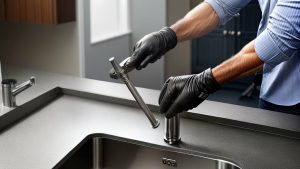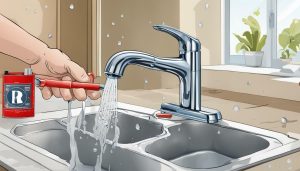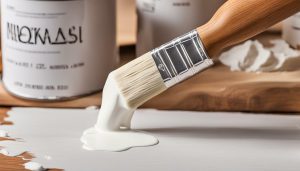Are you planning a kitchen renovation and need to remove your old cabinets? It’s important to follow proper techniques and precautions to avoid any damage or accidents during the process. In this article, we’ll guide you through the step-by-step process of safely removing kitchen cabinets.
Key Takeaways
- Removing kitchen cabinets is an important step in a kitchen renovation.
- You’ll need the right tools and equipment for the job.
- It’s important to take safety precautions to avoid accidents.
- Preparing the area and properly disposing of the cabinets are both important.
Why Remove Kitchen Cabinets?
If you’re considering a kitchen renovation, removing cabinets is a crucial step in updating the space and creating a fresh look. Whether you’re looking for more storage, a more modern aesthetic, or simply want to change up the layout of the kitchen, removing cabinets can help you achieve your goals.
By removing cabinets, you can also create more open space in the kitchen, making it feel larger and more inviting. This can be especially valuable if you have a smaller kitchen or if you entertain frequently and need more room for guests to gather.
Additionally, removing cabinets can be a cost-effective way to update your kitchen. Instead of investing in a full kitchen remodel, removing cabinets can give your kitchen a new look without breaking the bank.
Whether you’re planning on doing a full kitchen renovation or just want to make a few updates, removing cabinets can be an effective way to transform your space. With the right tools and techniques, you can safely and efficiently remove your cabinets and create the kitchen of your dreams.
Tools and Equipment Needed
Removing kitchen cabinets can be a challenging task that requires specialized tools and equipment. Here’s a list of the necessary tools you’ll need for a safe and efficient cabinet removal:
| Tool/Equipment | Purpose |
|---|---|
| Screwdriver | To remove screws holding the cabinets to the wall. |
| Pry Bar/ Crowbar | To detach cabinets from the wall and separate them from each other. |
| Gloves | To protect your hands from cuts, blisters, and splinters. |
| Safety goggles | To protect your eyes from dust and debris. |
| Drill | To drill holes into the cabinets or walls, especially if screws are stuck or difficult to remove. |
| Hammer | To tap gently on the cabinets and loosen them from the wall. |
Having the proper tools and equipment is essential to avoid unnecessary damage to the cabinets and surrounding area. It will also help you save time and energy, ensuring a successful cabinet removal process.
Safety Precautions for Removing Kitchen Cabinets
Removing kitchen cabinets can be a strenuous and potentially hazardous task. It is crucial to take proper safety precautions to avoid accidents and injuries during the process. Here are some important safety tips to keep in mind:
- Turn off the electricity: Before starting, ensure the power supply to the kitchen has been turned off to prevent electrocution.
- Wear protective gear: Wear gloves and safety goggles to protect your hands and eyes from dust, debris, and any potential accidents.
- Stabilize the cabinets: Make sure the cabinets are well supported and stable before starting.
- Take care with sharp objects: Use caution when handling sharp objects like screwdrivers and pry bars.
- Use a step ladder: When removing upper cabinets, use a step ladder to reach the necessary height rather than standing on countertops or chairs.
- Ask for help: If the cabinets are too heavy to handle alone, ask for assistance from someone else.
By following these safety precautions, you can successfully remove kitchen cabinets without putting yourself or others in harm’s way.
Preparing the Area
Before removing kitchen cabinets, it’s essential to prepare the area to avoid any damage to the walls or surrounding surfaces. Here are some tips to help you remove cabinets without damaging walls:
- Cover the flooring with a drop cloth
- Protect the countertops with cardboard or a plastic sheet
- Clear the area of any obstacles or furniture
- Remove any items from the cabinets before starting the removal process
- Label the cabinet doors and drawers to ensure easy re-installation
By preparing the area carefully, you can ensure a clean and organized workspace, making the process of removing kitchen cabinets more efficient and less stressful.
Removing Cabinet Doors and Drawers
Before attempting to remove the cabinets from the wall, it is essential to detach the doors and drawers first. This will make the cabinets lighter and easier to handle. Follow these DIY kitchen cabinet removal steps carefully:
- Start with the cabinet doors. Open the doors and remove the hinges and screws that hold them in place. Use a screwdriver to detach the hinges from the cabinet frame.
- If there are any drawers in the cabinets, remove them next. Locate the drawer slides and use a screwdriver to unscrew them from the cabinet frame.
- Once all the doors and drawers are removed, set them aside in a safe place. Make sure to label them correctly to easily restore them later.
Removing the doors and drawers can be the most straightforward part of the process if done correctly. Ensure that you have a safe and clean workspace to avoid any accidents that may occur during the process.
Detaching Cabinets from the Wall
Before detaching the cabinets from the wall, make sure you have cleared out all items from them.
Follow these steps to safely detach cabinets from the wall:
- Use a stud finder to locate the wall studs behind the cabinet. Mark their location with a pencil.
- Remove all screws that connect the cabinet to the wall using a drill or screwdriver.
- Have someone support the cabinet while detaching it from the wall. Once the screws are removed, gently pull the cabinet away from the wall.
- If there is any adhesive, foam, or caulking behind the cabinet, gently pry it off with a putty knife or scraper.
- Remove any remaining screws or fasteners from the back of the cabinet to release it from the wall.
Following these steps will ensure a smooth and safe cabinet removal process.
Removing Base Cabinets
Removing base cabinets requires a bit more effort than removing upper cabinets due to their size and weight. However, by following these techniques for removing kitchen cabinets, you can safely and efficiently detach the base cabinets from the wall.
Step 1: Clear Out the Cabinets
Before starting to remove the base cabinets, clear out all the contents from the cabinets and drawers. This will make it easier to work and prevent any items from falling out during the removal process.
Step 2: Remove the Countertops
Next, remove any attached countertops from the base cabinets. This will make it easier to access the cabinets and prevent any damage to the countertops during the removal process.
Step 3: Loosen the Screws and Fasteners
Starting at the corners, use a screwdriver or drill to loosen the screws and fasteners that secure the base cabinets to the wall. Take care to support the weight of the cabinets to prevent them from falling or tipping over.
Step 4: Detach the Cabinets from the Wall
With the screws and fasteners loosened, gently lift the base cabinets away from the wall. Take care to support the weight of the cabinets and detach them securely from any remaining screws or fasteners. Avoid dragging the cabinets to prevent any damage to the flooring or walls.
Professional cabinet removal methods may involve using a pry bar or other specialized tools to loosen and detach the cabinets from the wall. If you are unsure about the proper techniques, it may be best to consult a professional to ensure a safe and effective removal process.
Removing Upper Cabinets
Removing upper cabinets can be a bit more challenging than base cabinets due to their height and weight. However, with the right techniques and tools, it can be done safely and efficiently.
Step 1: Empty the Cabinets
Before removing the upper cabinets, ensure that they are completely empty and free from any items or kitchenware. This will make the cabinets lighter and easier to handle during the removal process.
Step 2: Turn Off Electricity
As with removing base cabinets, it’s important to turn off the electricity in the kitchen to avoid any electrical hazards. This can be done by switching off the circuit breaker or unplugging any electrical appliances.
Step 3: Detach the Cabinets from the Wall
Using the same techniques as removing base cabinets, start by loosening any screws or fasteners that attach the cabinet to the wall. Use a pry bar to gently detach the cabinet from the wall, taking care not to damage the drywall or surrounding areas.
Step 4: Remove the Cabinets
Once the cabinet is detached from the wall, have a helper assist in safely lowering the cabinet to the ground. It’s important to use proper lifting techniques and avoid any sudden movements that could damage the cabinet or cause injury.
Professional cabinet removal methods may involve using specialized equipment such as cabinet lifters or pulleys to safely remove upper cabinets. If you’re unsure about your ability to safely remove the cabinets on your own, it may be best to seek professional assistance.
Disposing of Cabinets
Once the kitchen cabinets have been safely removed, it is essential to dispose of them properly. Here are some helpful tips to ensure that the process is eco-friendly and efficient:
- Recycling: Consider recycling the cabinets if they are still in good condition. Contact your local recycling center or check with local community groups to see if they accept used cabinets. You can also donate them to nonprofit organizations such as Habitat for Humanity.
- Waste disposal: If you cannot recycle the cabinets, arrange for proper waste disposal. Contact your local waste management company to find out the regulations and requirements for disposing of bulky items such as cabinets.
Remember to take care when handling the cabinets during the disposal process to avoid any injuries or accidents. Additionally, consider repurposing any salvageable parts of the cabinets such as drawers or shelves for other DIY projects.
Cleaning and Preparing for Installation
After successfully removing your old kitchen cabinets, it’s time to start prepping the space for the installation of new ones. Here are some helpful kitchen cabinet removal tips for cleaning and preparing your kitchen:
- Start by removing any debris, such as screws or nails left behind from the previous cabinets.
- Clean the walls thoroughly, removing any dirt or debris that may interfere with the new installation.
- Wipe down the floors and countertops to ensure they’re clean and ready for use.
- If there are any electrical or plumbing changes required for the new cabinets, now is the time to address them before installation.
- Consider painting or refinishing the walls, as this can add a fresh look to your kitchen and complement the new cabinets.
By taking the time to clean and prepare the area properly, you can ensure a smooth and successful installation of your new kitchen cabinets.
Conclusion
Removing kitchen cabinets is an essential part of any kitchen renovation project, and doing it yourself can save you a lot of money. However, it is crucial to follow proper techniques and precautions to ensure a safe and successful process.
We have discussed the importance of safety precautions such as turning off electricity and wearing protective gear, as well as preparing the area and disposing of the cabinets properly. Additionally, we provided step-by-step instructions for removing and detaching base and upper cabinets, as well as removing drawers and doors.
It is essential to clean and prepare the area before installing new cabinets to ensure a clean and organized kitchen space. By following these tips and techniques, you can safely and efficiently remove your kitchen cabinets and prepare for a beautiful and functional kitchen renovation.
FAQ
Q: Can I safely remove kitchen cabinets myself?
A: Yes, you can safely remove kitchen cabinets yourself by following proper techniques and taking necessary precautions.
Q: What tools and equipment do I need to remove kitchen cabinets?
A: You will need tools such as screwdrivers, pry bars, safety goggles, gloves, and possibly other tools depending on the specific cabinets.
Q: How do I ensure that I don’t damage the walls when removing cabinets?
A: To avoid damaging the walls, you can take precautions such as protecting the surrounding surfaces, using care when detaching cabinets, and ensuring a clean and organized workspace.
Q: Do I need to turn off the electricity before removing kitchen cabinets?
A: Yes, it is important to turn off the electricity to the area where you will be working to ensure safety and prevent any electrical accidents.
Q: How do I dispose of the old cabinets?
A: You can consider options like recycling, donating, or arranging for proper waste disposal to ensure an eco-friendly approach to cabinet disposal.
Q: What are the steps for removing cabinet doors and drawers?
A: The steps for removing cabinet doors and drawers include detaching hinges and handles, carefully lifting and removing the doors, and sliding out the drawers.
Q: How do I detach the cabinets from the wall?
A: To detach cabinets from the wall, you will need to locate and remove any screws or fasteners holding them in place. Taking support and weight distribution into account is essential.
Q: What are the techniques for removing base cabinets?
A: Techniques for removing base cabinets include loosening any screws or fasteners, supporting the weight evenly, and detaching the cabinets carefully to avoid any damage.
Q: How do I safely remove upper cabinets?
A: Safely removing upper cabinets involves detaching screws or fasteners, supporting the cabinets while removing them, and ensuring stability and weight distribution.
Q: How should I clean and prepare the kitchen space after cabinet removal?
A: Cleaning and preparing the kitchen space after cabinet removal involves removing debris, cleaning the walls and flooring, and ensuring a clean and ready-to-use environment for the installation of new cabinets.

It’s me, Amber Hayden, the heart and soul behind SagarmathaOnlineMedia.com. From a young age, I’ve been head over heels for everything home-related, from interior decor to gardening. I’m the type who can’t resist a well-crafted piece of furniture, and I firmly believe that a home isn’t complete without a pet or two. But it’s not just about creating pretty spaces for me. I’m all about making homes that tell a story reflecting the people living there. SagarmathaOnlineMedia.com is my way of sharing this passion with you. Whether you’re looking for tips to jazz up your living room, advice on pet care, or ideas to make your garden bloom, I’m here to help. So, let’s embark on this journey together and make your house a home!



